BTEC HND: HRM Functions, Recruitment, and Thirdway Group Case
VerifiedAdded on 2023/04/23
|11
|2336
|376
Case Study
AI Summary
This case study provides an overview of Human Resource Management (HRM) functions, focusing on their purpose and scope within organizations. It explores the operational, managerial, and advisory roles of HRM, including recruitment, training, employee management, and policy advice, using the Thirdway Group as a practical example. The report assesses the strengths and weaknesses of different recruitment approaches, such as job descriptions and multi-step processes, and concludes by highlighting the significance of HRM in fostering a healthy and productive work environment. Desklib offers a platform for students to access similar solved assignments and study resources.
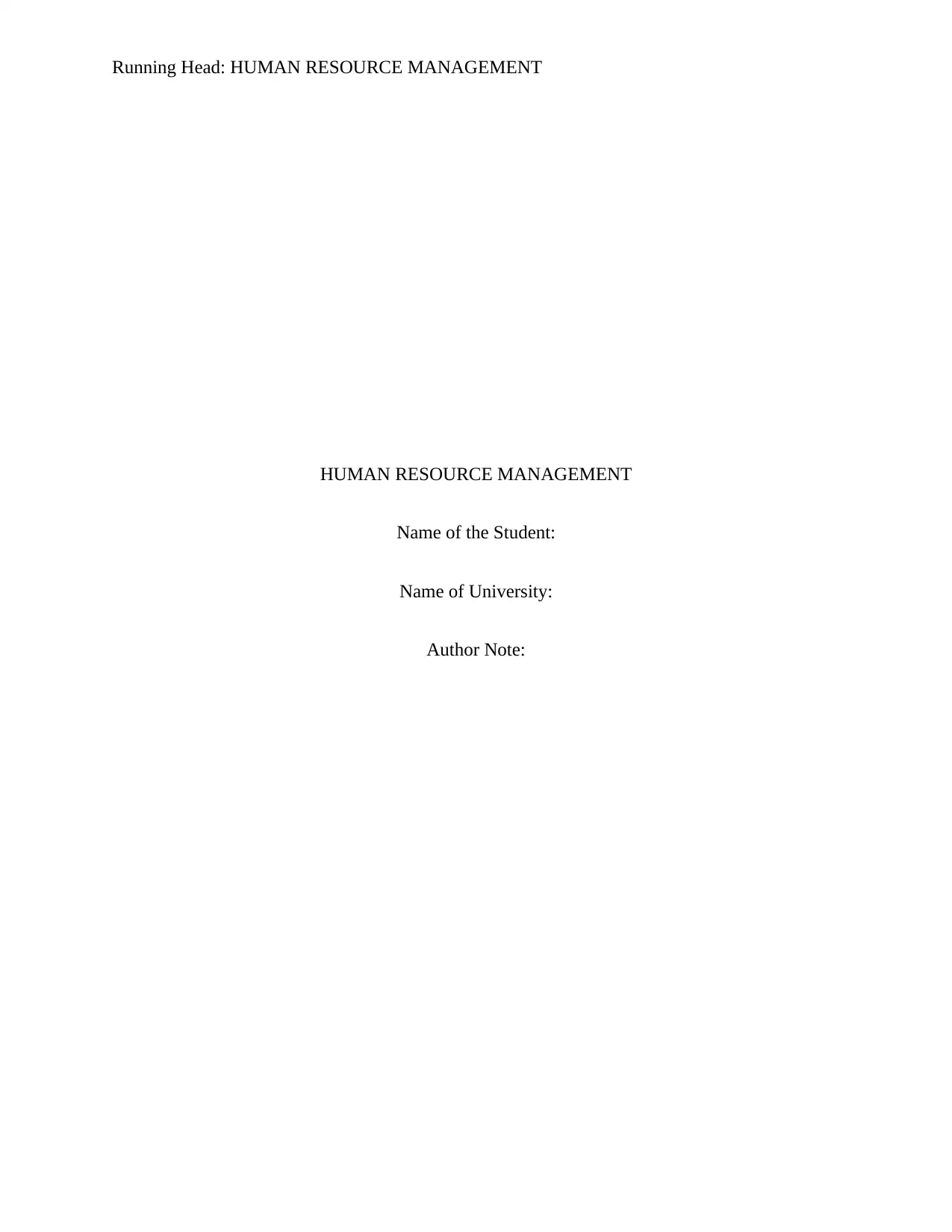
Running Head: HUMAN RESOURCE MANAGEMENT
HUMAN RESOURCE MANAGEMENT
Name of the Student:
Name of University:
Author Note:
HUMAN RESOURCE MANAGEMENT
Name of the Student:
Name of University:
Author Note:
Paraphrase This Document
Need a fresh take? Get an instant paraphrase of this document with our AI Paraphraser
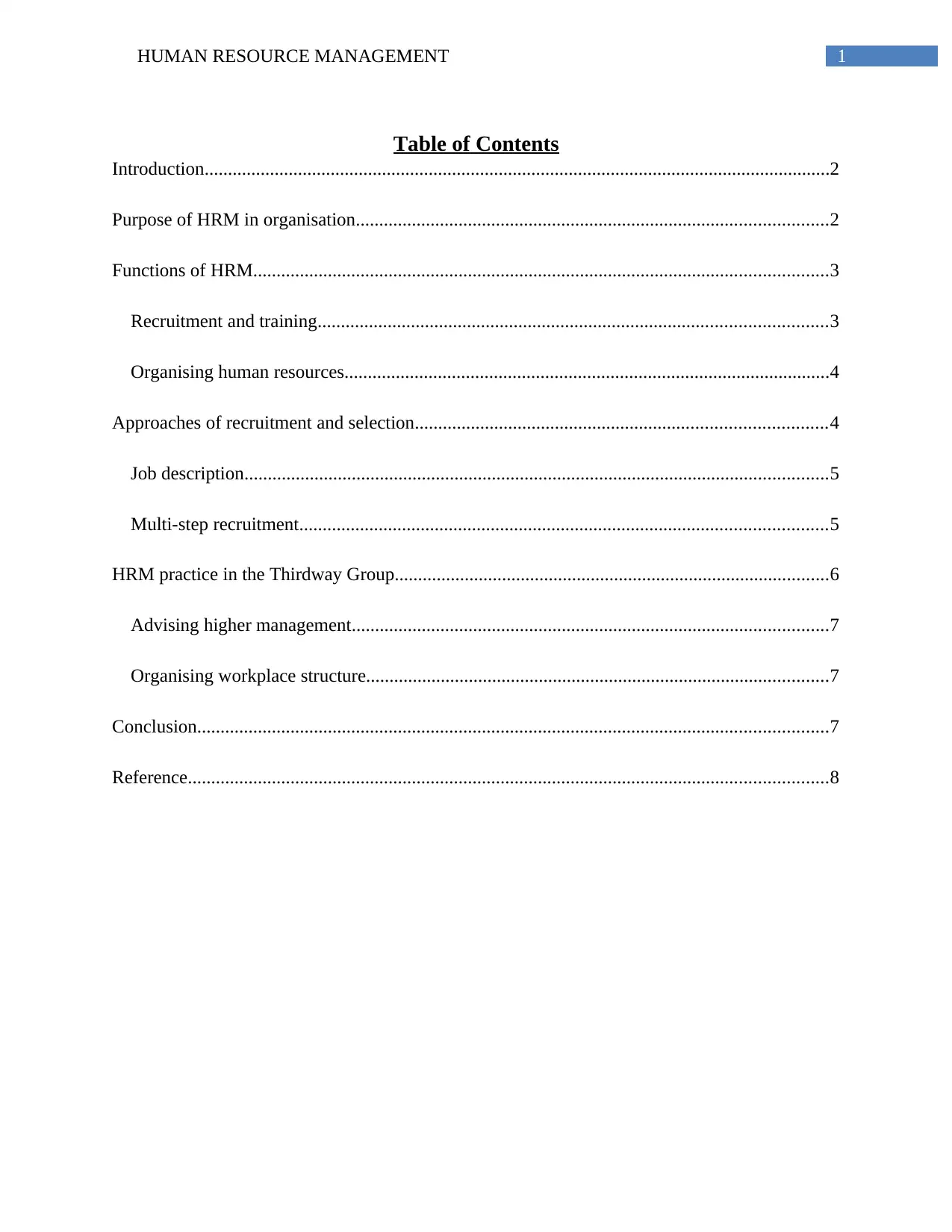
1HUMAN RESOURCE MANAGEMENT
Table of Contents
Introduction......................................................................................................................................2
Purpose of HRM in organisation.....................................................................................................2
Functions of HRM...........................................................................................................................3
Recruitment and training.............................................................................................................3
Organising human resources........................................................................................................4
Approaches of recruitment and selection........................................................................................4
Job description.............................................................................................................................5
Multi-step recruitment.................................................................................................................5
HRM practice in the Thirdway Group.............................................................................................6
Advising higher management......................................................................................................7
Organising workplace structure...................................................................................................7
Conclusion.......................................................................................................................................7
Reference.........................................................................................................................................8
Table of Contents
Introduction......................................................................................................................................2
Purpose of HRM in organisation.....................................................................................................2
Functions of HRM...........................................................................................................................3
Recruitment and training.............................................................................................................3
Organising human resources........................................................................................................4
Approaches of recruitment and selection........................................................................................4
Job description.............................................................................................................................5
Multi-step recruitment.................................................................................................................5
HRM practice in the Thirdway Group.............................................................................................6
Advising higher management......................................................................................................7
Organising workplace structure...................................................................................................7
Conclusion.......................................................................................................................................7
Reference.........................................................................................................................................8
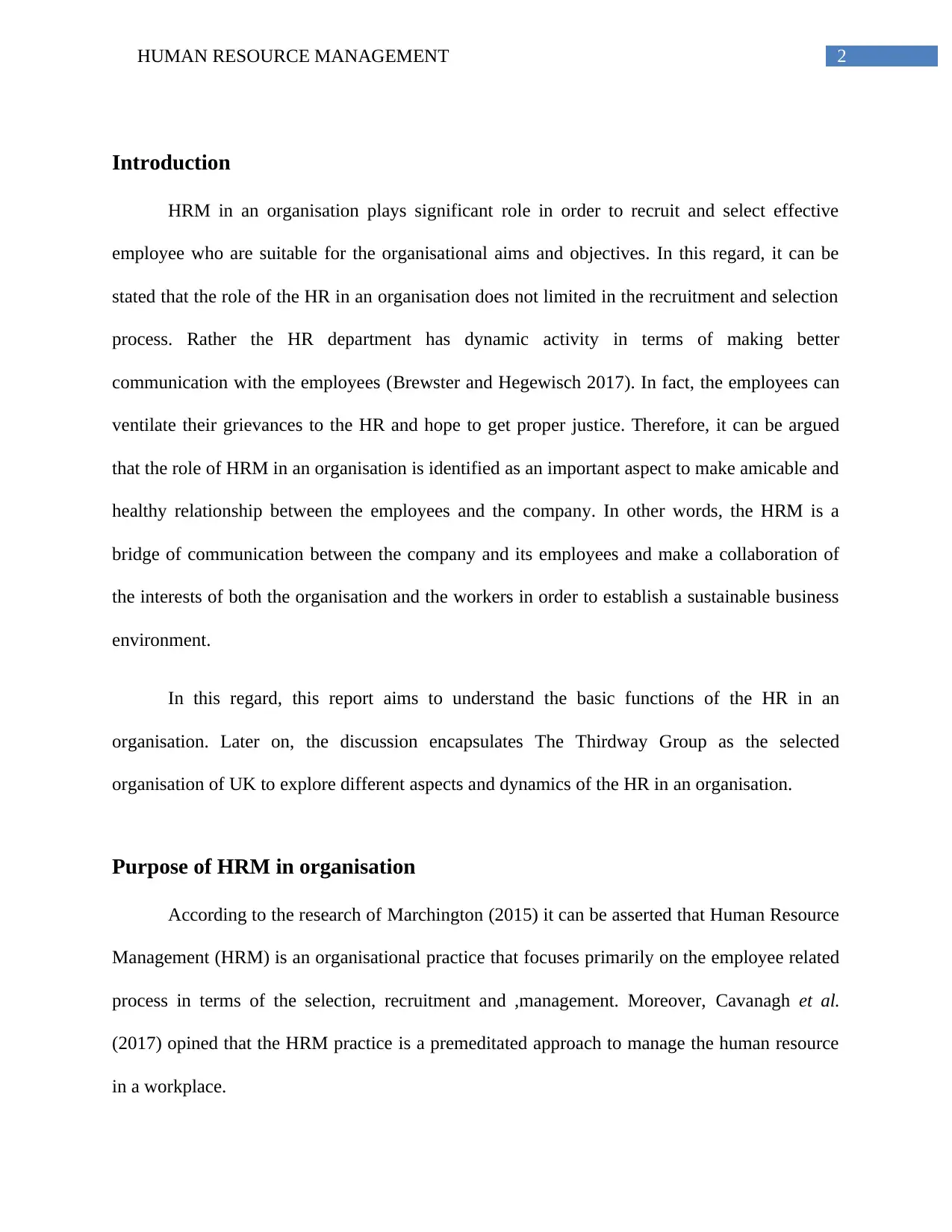
2HUMAN RESOURCE MANAGEMENT
Introduction
HRM in an organisation plays significant role in order to recruit and select effective
employee who are suitable for the organisational aims and objectives. In this regard, it can be
stated that the role of the HR in an organisation does not limited in the recruitment and selection
process. Rather the HR department has dynamic activity in terms of making better
communication with the employees (Brewster and Hegewisch 2017). In fact, the employees can
ventilate their grievances to the HR and hope to get proper justice. Therefore, it can be argued
that the role of HRM in an organisation is identified as an important aspect to make amicable and
healthy relationship between the employees and the company. In other words, the HRM is a
bridge of communication between the company and its employees and make a collaboration of
the interests of both the organisation and the workers in order to establish a sustainable business
environment.
In this regard, this report aims to understand the basic functions of the HR in an
organisation. Later on, the discussion encapsulates The Thirdway Group as the selected
organisation of UK to explore different aspects and dynamics of the HR in an organisation.
Purpose of HRM in organisation
According to the research of Marchington (2015) it can be asserted that Human Resource
Management (HRM) is an organisational practice that focuses primarily on the employee related
process in terms of the selection, recruitment and ,management. Moreover, Cavanagh et al.
(2017) opined that the HRM practice is a premeditated approach to manage the human resource
in a workplace.
Introduction
HRM in an organisation plays significant role in order to recruit and select effective
employee who are suitable for the organisational aims and objectives. In this regard, it can be
stated that the role of the HR in an organisation does not limited in the recruitment and selection
process. Rather the HR department has dynamic activity in terms of making better
communication with the employees (Brewster and Hegewisch 2017). In fact, the employees can
ventilate their grievances to the HR and hope to get proper justice. Therefore, it can be argued
that the role of HRM in an organisation is identified as an important aspect to make amicable and
healthy relationship between the employees and the company. In other words, the HRM is a
bridge of communication between the company and its employees and make a collaboration of
the interests of both the organisation and the workers in order to establish a sustainable business
environment.
In this regard, this report aims to understand the basic functions of the HR in an
organisation. Later on, the discussion encapsulates The Thirdway Group as the selected
organisation of UK to explore different aspects and dynamics of the HR in an organisation.
Purpose of HRM in organisation
According to the research of Marchington (2015) it can be asserted that Human Resource
Management (HRM) is an organisational practice that focuses primarily on the employee related
process in terms of the selection, recruitment and ,management. Moreover, Cavanagh et al.
(2017) opined that the HRM practice is a premeditated approach to manage the human resource
in a workplace.
⊘ This is a preview!⊘
Do you want full access?
Subscribe today to unlock all pages.

Trusted by 1+ million students worldwide
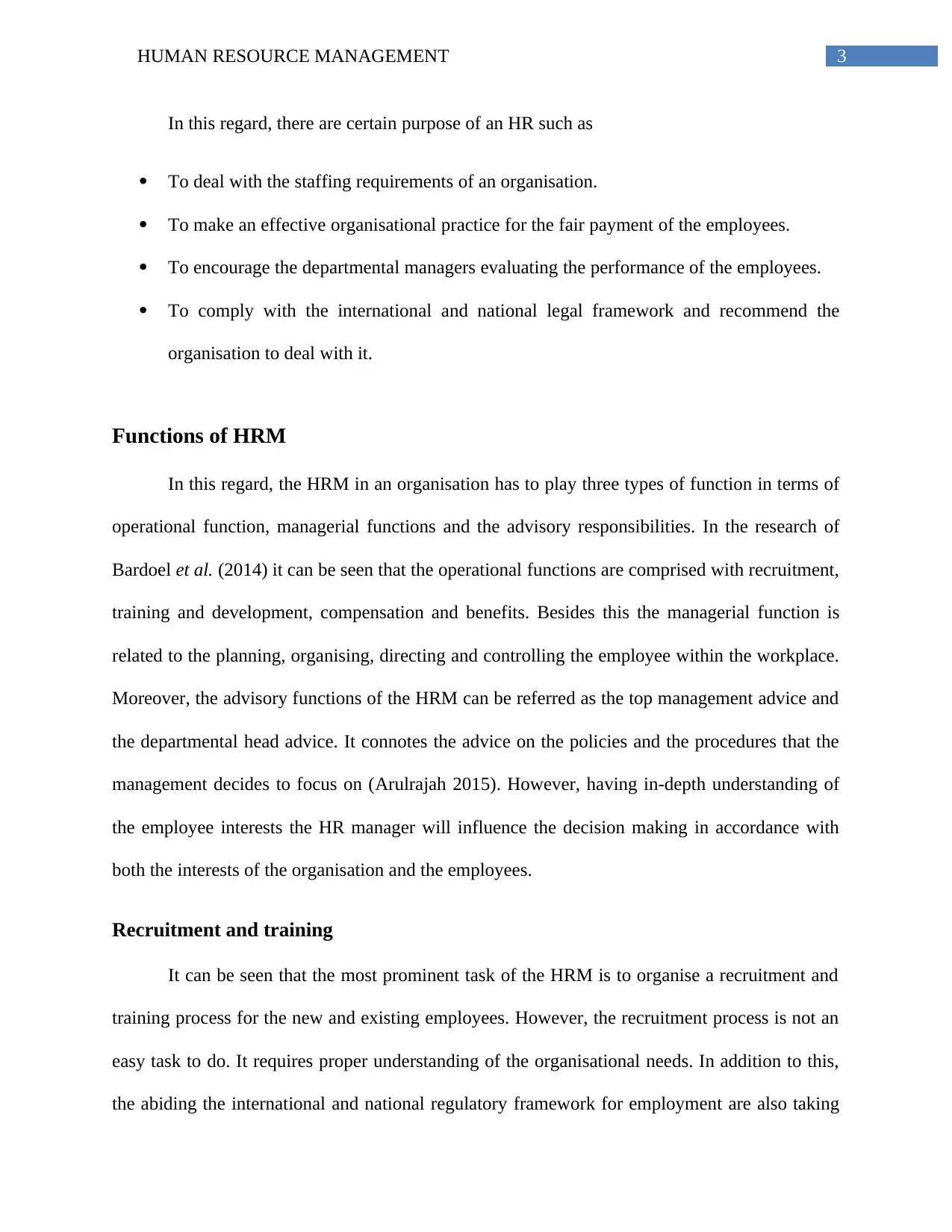
3HUMAN RESOURCE MANAGEMENT
In this regard, there are certain purpose of an HR such as
To deal with the staffing requirements of an organisation.
To make an effective organisational practice for the fair payment of the employees.
To encourage the departmental managers evaluating the performance of the employees.
To comply with the international and national legal framework and recommend the
organisation to deal with it.
Functions of HRM
In this regard, the HRM in an organisation has to play three types of function in terms of
operational function, managerial functions and the advisory responsibilities. In the research of
Bardoel et al. (2014) it can be seen that the operational functions are comprised with recruitment,
training and development, compensation and benefits. Besides this the managerial function is
related to the planning, organising, directing and controlling the employee within the workplace.
Moreover, the advisory functions of the HRM can be referred as the top management advice and
the departmental head advice. It connotes the advice on the policies and the procedures that the
management decides to focus on (Arulrajah 2015). However, having in-depth understanding of
the employee interests the HR manager will influence the decision making in accordance with
both the interests of the organisation and the employees.
Recruitment and training
It can be seen that the most prominent task of the HRM is to organise a recruitment and
training process for the new and existing employees. However, the recruitment process is not an
easy task to do. It requires proper understanding of the organisational needs. In addition to this,
the abiding the international and national regulatory framework for employment are also taking
In this regard, there are certain purpose of an HR such as
To deal with the staffing requirements of an organisation.
To make an effective organisational practice for the fair payment of the employees.
To encourage the departmental managers evaluating the performance of the employees.
To comply with the international and national legal framework and recommend the
organisation to deal with it.
Functions of HRM
In this regard, the HRM in an organisation has to play three types of function in terms of
operational function, managerial functions and the advisory responsibilities. In the research of
Bardoel et al. (2014) it can be seen that the operational functions are comprised with recruitment,
training and development, compensation and benefits. Besides this the managerial function is
related to the planning, organising, directing and controlling the employee within the workplace.
Moreover, the advisory functions of the HRM can be referred as the top management advice and
the departmental head advice. It connotes the advice on the policies and the procedures that the
management decides to focus on (Arulrajah 2015). However, having in-depth understanding of
the employee interests the HR manager will influence the decision making in accordance with
both the interests of the organisation and the employees.
Recruitment and training
It can be seen that the most prominent task of the HRM is to organise a recruitment and
training process for the new and existing employees. However, the recruitment process is not an
easy task to do. It requires proper understanding of the organisational needs. In addition to this,
the abiding the international and national regulatory framework for employment are also taking
Paraphrase This Document
Need a fresh take? Get an instant paraphrase of this document with our AI Paraphraser
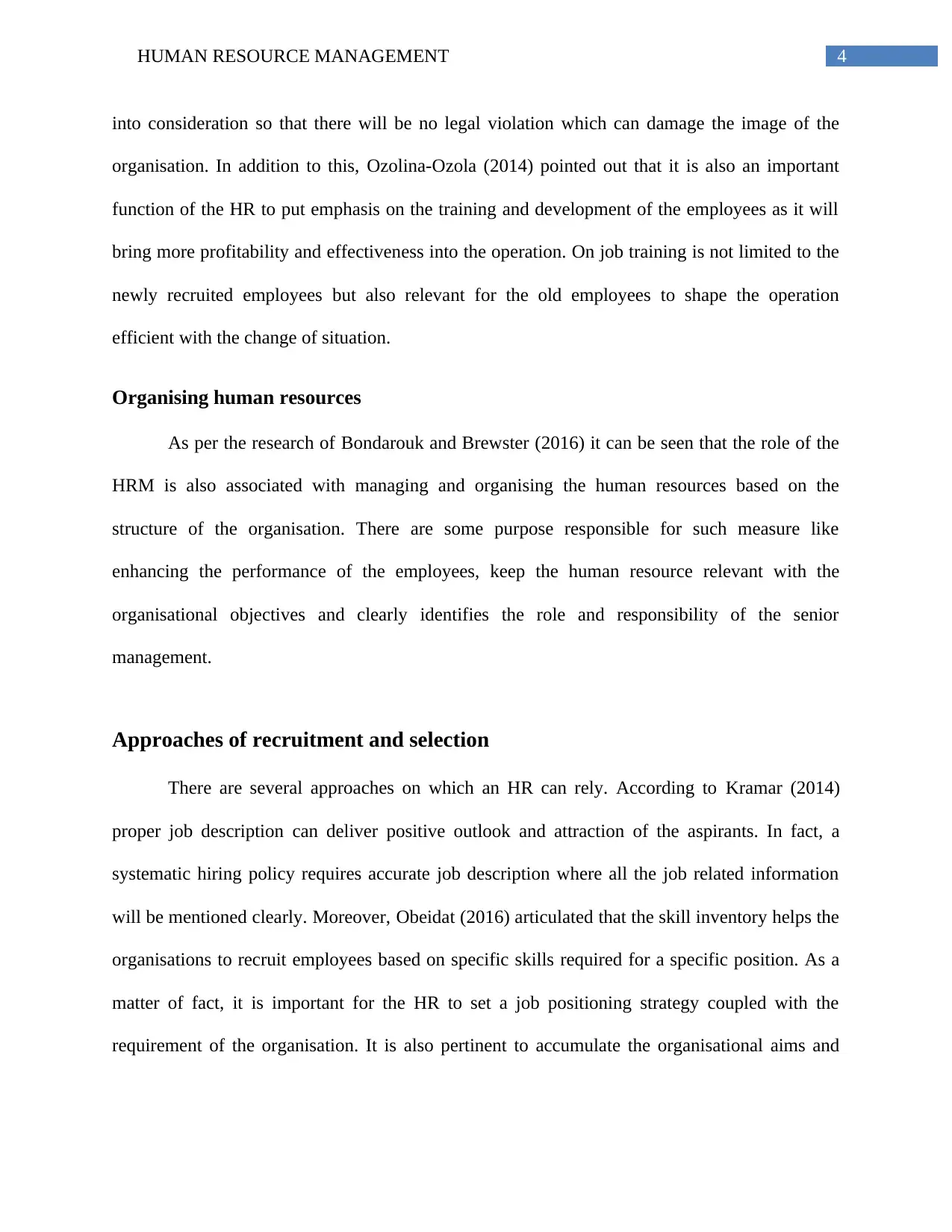
4HUMAN RESOURCE MANAGEMENT
into consideration so that there will be no legal violation which can damage the image of the
organisation. In addition to this, Ozolina-Ozola (2014) pointed out that it is also an important
function of the HR to put emphasis on the training and development of the employees as it will
bring more profitability and effectiveness into the operation. On job training is not limited to the
newly recruited employees but also relevant for the old employees to shape the operation
efficient with the change of situation.
Organising human resources
As per the research of Bondarouk and Brewster (2016) it can be seen that the role of the
HRM is also associated with managing and organising the human resources based on the
structure of the organisation. There are some purpose responsible for such measure like
enhancing the performance of the employees, keep the human resource relevant with the
organisational objectives and clearly identifies the role and responsibility of the senior
management.
Approaches of recruitment and selection
There are several approaches on which an HR can rely. According to Kramar (2014)
proper job description can deliver positive outlook and attraction of the aspirants. In fact, a
systematic hiring policy requires accurate job description where all the job related information
will be mentioned clearly. Moreover, Obeidat (2016) articulated that the skill inventory helps the
organisations to recruit employees based on specific skills required for a specific position. As a
matter of fact, it is important for the HR to set a job positioning strategy coupled with the
requirement of the organisation. It is also pertinent to accumulate the organisational aims and
into consideration so that there will be no legal violation which can damage the image of the
organisation. In addition to this, Ozolina-Ozola (2014) pointed out that it is also an important
function of the HR to put emphasis on the training and development of the employees as it will
bring more profitability and effectiveness into the operation. On job training is not limited to the
newly recruited employees but also relevant for the old employees to shape the operation
efficient with the change of situation.
Organising human resources
As per the research of Bondarouk and Brewster (2016) it can be seen that the role of the
HRM is also associated with managing and organising the human resources based on the
structure of the organisation. There are some purpose responsible for such measure like
enhancing the performance of the employees, keep the human resource relevant with the
organisational objectives and clearly identifies the role and responsibility of the senior
management.
Approaches of recruitment and selection
There are several approaches on which an HR can rely. According to Kramar (2014)
proper job description can deliver positive outlook and attraction of the aspirants. In fact, a
systematic hiring policy requires accurate job description where all the job related information
will be mentioned clearly. Moreover, Obeidat (2016) articulated that the skill inventory helps the
organisations to recruit employees based on specific skills required for a specific position. As a
matter of fact, it is important for the HR to set a job positioning strategy coupled with the
requirement of the organisation. It is also pertinent to accumulate the organisational aims and
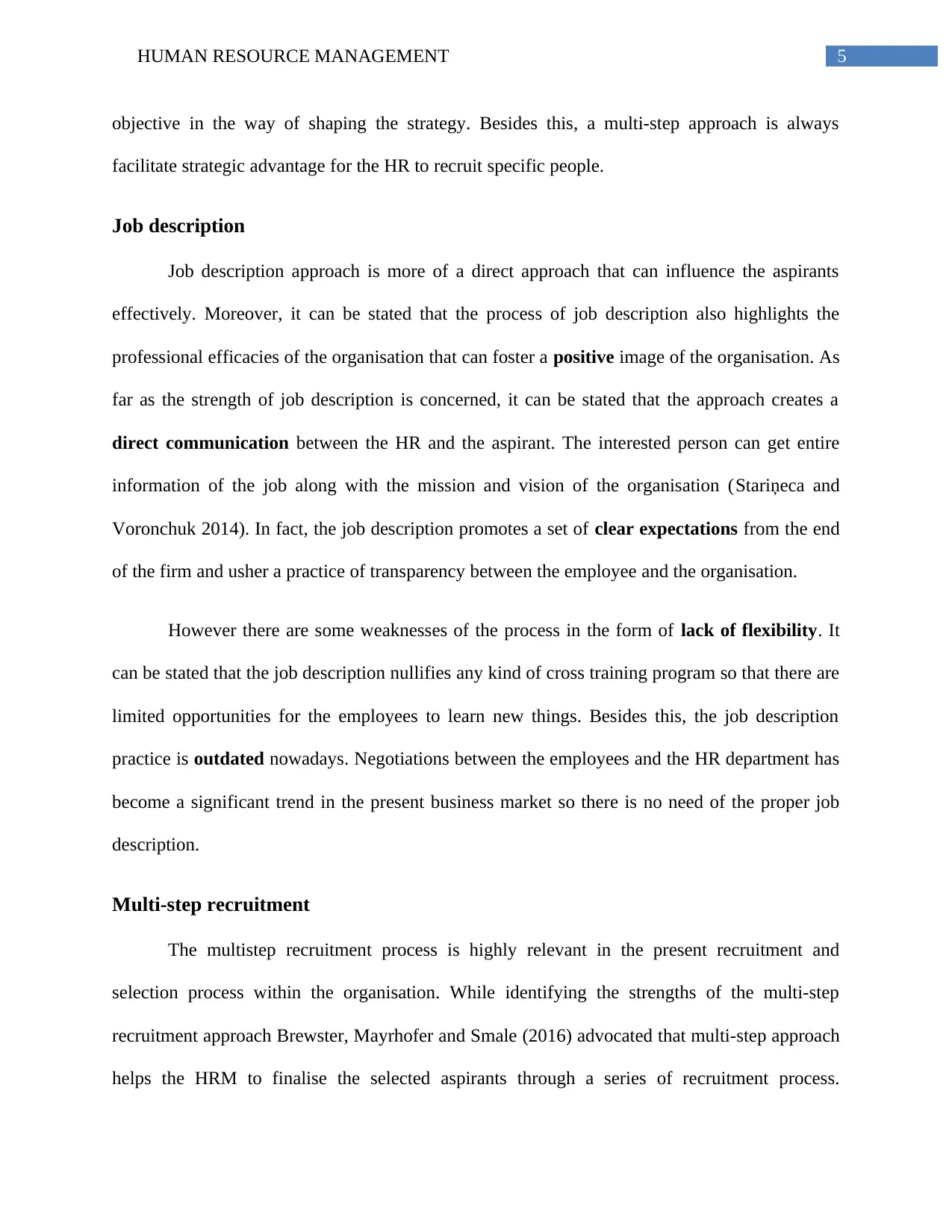
5HUMAN RESOURCE MANAGEMENT
objective in the way of shaping the strategy. Besides this, a multi-step approach is always
facilitate strategic advantage for the HR to recruit specific people.
Job description
Job description approach is more of a direct approach that can influence the aspirants
effectively. Moreover, it can be stated that the process of job description also highlights the
professional efficacies of the organisation that can foster a positive image of the organisation. As
far as the strength of job description is concerned, it can be stated that the approach creates a
direct communication between the HR and the aspirant. The interested person can get entire
information of the job along with the mission and vision of the organisation (Stariņeca and
Voronchuk 2014). In fact, the job description promotes a set of clear expectations from the end
of the firm and usher a practice of transparency between the employee and the organisation.
However there are some weaknesses of the process in the form of lack of flexibility. It
can be stated that the job description nullifies any kind of cross training program so that there are
limited opportunities for the employees to learn new things. Besides this, the job description
practice is outdated nowadays. Negotiations between the employees and the HR department has
become a significant trend in the present business market so there is no need of the proper job
description.
Multi-step recruitment
The multistep recruitment process is highly relevant in the present recruitment and
selection process within the organisation. While identifying the strengths of the multi-step
recruitment approach Brewster, Mayrhofer and Smale (2016) advocated that multi-step approach
helps the HRM to finalise the selected aspirants through a series of recruitment process.
objective in the way of shaping the strategy. Besides this, a multi-step approach is always
facilitate strategic advantage for the HR to recruit specific people.
Job description
Job description approach is more of a direct approach that can influence the aspirants
effectively. Moreover, it can be stated that the process of job description also highlights the
professional efficacies of the organisation that can foster a positive image of the organisation. As
far as the strength of job description is concerned, it can be stated that the approach creates a
direct communication between the HR and the aspirant. The interested person can get entire
information of the job along with the mission and vision of the organisation (Stariņeca and
Voronchuk 2014). In fact, the job description promotes a set of clear expectations from the end
of the firm and usher a practice of transparency between the employee and the organisation.
However there are some weaknesses of the process in the form of lack of flexibility. It
can be stated that the job description nullifies any kind of cross training program so that there are
limited opportunities for the employees to learn new things. Besides this, the job description
practice is outdated nowadays. Negotiations between the employees and the HR department has
become a significant trend in the present business market so there is no need of the proper job
description.
Multi-step recruitment
The multistep recruitment process is highly relevant in the present recruitment and
selection process within the organisation. While identifying the strengths of the multi-step
recruitment approach Brewster, Mayrhofer and Smale (2016) advocated that multi-step approach
helps the HRM to finalise the selected aspirants through a series of recruitment process.
⊘ This is a preview!⊘
Do you want full access?
Subscribe today to unlock all pages.

Trusted by 1+ million students worldwide
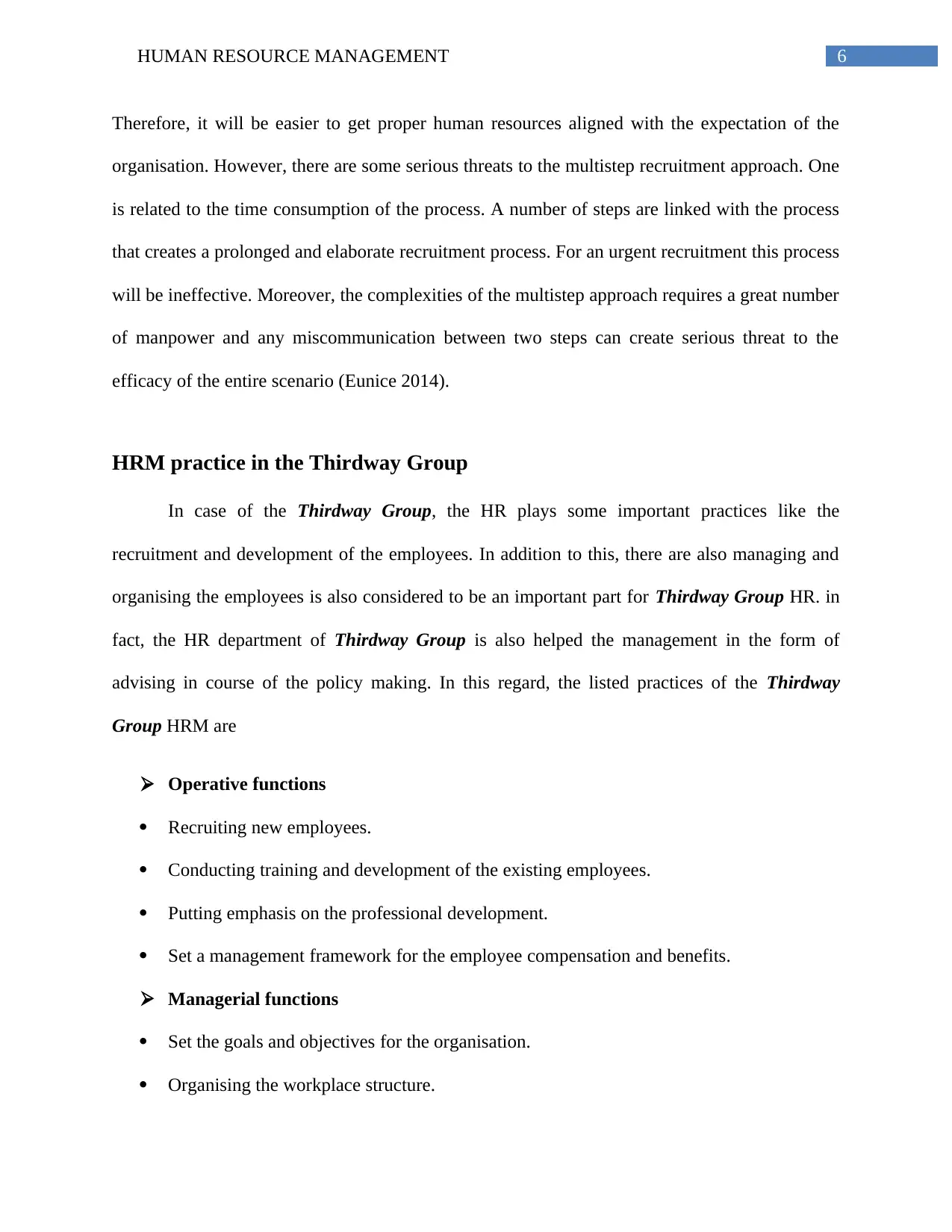
6HUMAN RESOURCE MANAGEMENT
Therefore, it will be easier to get proper human resources aligned with the expectation of the
organisation. However, there are some serious threats to the multistep recruitment approach. One
is related to the time consumption of the process. A number of steps are linked with the process
that creates a prolonged and elaborate recruitment process. For an urgent recruitment this process
will be ineffective. Moreover, the complexities of the multistep approach requires a great number
of manpower and any miscommunication between two steps can create serious threat to the
efficacy of the entire scenario (Eunice 2014).
HRM practice in the Thirdway Group
In case of the Thirdway Group, the HR plays some important practices like the
recruitment and development of the employees. In addition to this, there are also managing and
organising the employees is also considered to be an important part for Thirdway Group HR. in
fact, the HR department of Thirdway Group is also helped the management in the form of
advising in course of the policy making. In this regard, the listed practices of the Thirdway
Group HRM are
Operative functions
Recruiting new employees.
Conducting training and development of the existing employees.
Putting emphasis on the professional development.
Set a management framework for the employee compensation and benefits.
Managerial functions
Set the goals and objectives for the organisation.
Organising the workplace structure.
Therefore, it will be easier to get proper human resources aligned with the expectation of the
organisation. However, there are some serious threats to the multistep recruitment approach. One
is related to the time consumption of the process. A number of steps are linked with the process
that creates a prolonged and elaborate recruitment process. For an urgent recruitment this process
will be ineffective. Moreover, the complexities of the multistep approach requires a great number
of manpower and any miscommunication between two steps can create serious threat to the
efficacy of the entire scenario (Eunice 2014).
HRM practice in the Thirdway Group
In case of the Thirdway Group, the HR plays some important practices like the
recruitment and development of the employees. In addition to this, there are also managing and
organising the employees is also considered to be an important part for Thirdway Group HR. in
fact, the HR department of Thirdway Group is also helped the management in the form of
advising in course of the policy making. In this regard, the listed practices of the Thirdway
Group HRM are
Operative functions
Recruiting new employees.
Conducting training and development of the existing employees.
Putting emphasis on the professional development.
Set a management framework for the employee compensation and benefits.
Managerial functions
Set the goals and objectives for the organisation.
Organising the workplace structure.
Paraphrase This Document
Need a fresh take? Get an instant paraphrase of this document with our AI Paraphraser
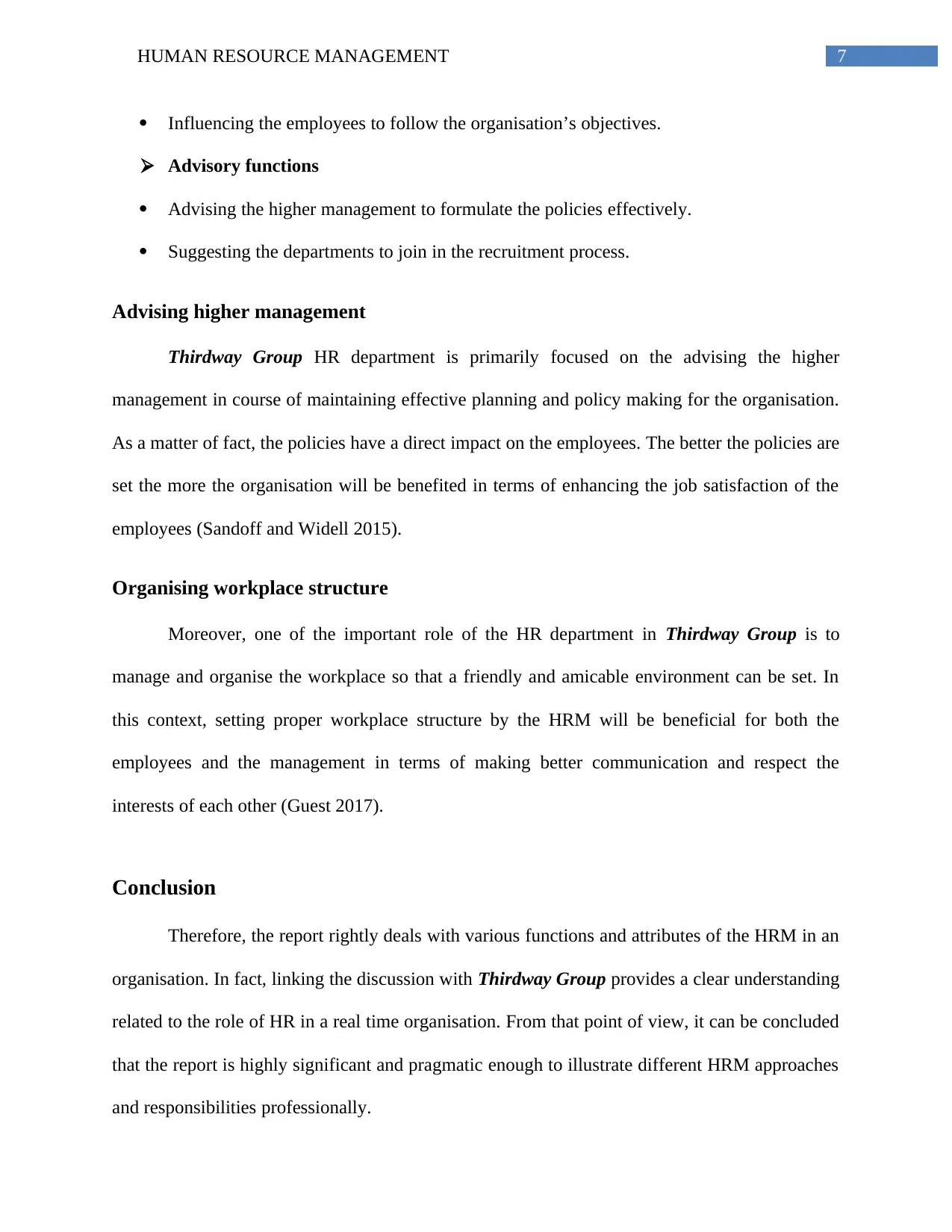
7HUMAN RESOURCE MANAGEMENT
Influencing the employees to follow the organisation’s objectives.
Advisory functions
Advising the higher management to formulate the policies effectively.
Suggesting the departments to join in the recruitment process.
Advising higher management
Thirdway Group HR department is primarily focused on the advising the higher
management in course of maintaining effective planning and policy making for the organisation.
As a matter of fact, the policies have a direct impact on the employees. The better the policies are
set the more the organisation will be benefited in terms of enhancing the job satisfaction of the
employees (Sandoff and Widell 2015).
Organising workplace structure
Moreover, one of the important role of the HR department in Thirdway Group is to
manage and organise the workplace so that a friendly and amicable environment can be set. In
this context, setting proper workplace structure by the HRM will be beneficial for both the
employees and the management in terms of making better communication and respect the
interests of each other (Guest 2017).
Conclusion
Therefore, the report rightly deals with various functions and attributes of the HRM in an
organisation. In fact, linking the discussion with Thirdway Group provides a clear understanding
related to the role of HR in a real time organisation. From that point of view, it can be concluded
that the report is highly significant and pragmatic enough to illustrate different HRM approaches
and responsibilities professionally.
Influencing the employees to follow the organisation’s objectives.
Advisory functions
Advising the higher management to formulate the policies effectively.
Suggesting the departments to join in the recruitment process.
Advising higher management
Thirdway Group HR department is primarily focused on the advising the higher
management in course of maintaining effective planning and policy making for the organisation.
As a matter of fact, the policies have a direct impact on the employees. The better the policies are
set the more the organisation will be benefited in terms of enhancing the job satisfaction of the
employees (Sandoff and Widell 2015).
Organising workplace structure
Moreover, one of the important role of the HR department in Thirdway Group is to
manage and organise the workplace so that a friendly and amicable environment can be set. In
this context, setting proper workplace structure by the HRM will be beneficial for both the
employees and the management in terms of making better communication and respect the
interests of each other (Guest 2017).
Conclusion
Therefore, the report rightly deals with various functions and attributes of the HRM in an
organisation. In fact, linking the discussion with Thirdway Group provides a clear understanding
related to the role of HR in a real time organisation. From that point of view, it can be concluded
that the report is highly significant and pragmatic enough to illustrate different HRM approaches
and responsibilities professionally.
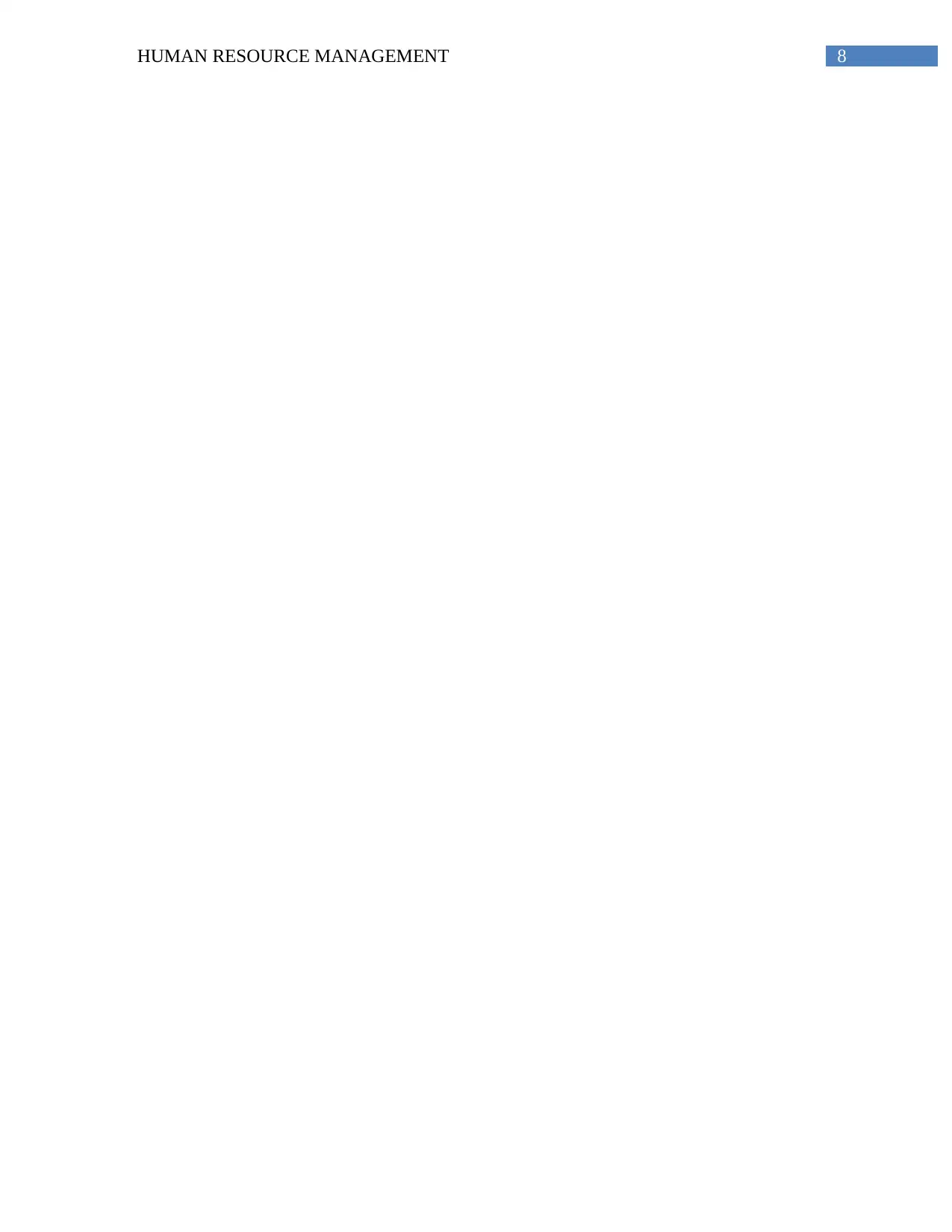
8HUMAN RESOURCE MANAGEMENT
⊘ This is a preview!⊘
Do you want full access?
Subscribe today to unlock all pages.

Trusted by 1+ million students worldwide
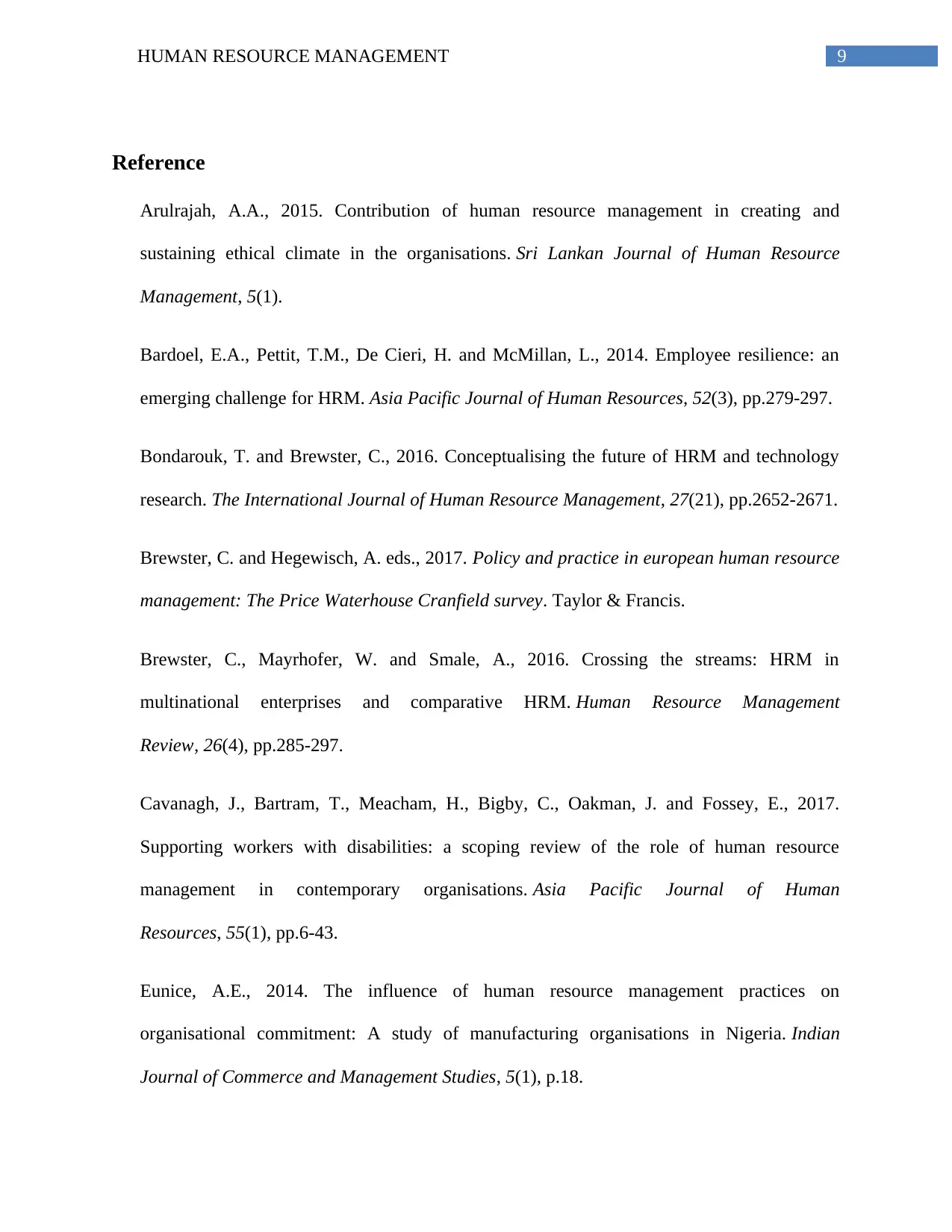
9HUMAN RESOURCE MANAGEMENT
Reference
Arulrajah, A.A., 2015. Contribution of human resource management in creating and
sustaining ethical climate in the organisations. Sri Lankan Journal of Human Resource
Management, 5(1).
Bardoel, E.A., Pettit, T.M., De Cieri, H. and McMillan, L., 2014. Employee resilience: an
emerging challenge for HRM. Asia Pacific Journal of Human Resources, 52(3), pp.279-297.
Bondarouk, T. and Brewster, C., 2016. Conceptualising the future of HRM and technology
research. The International Journal of Human Resource Management, 27(21), pp.2652-2671.
Brewster, C. and Hegewisch, A. eds., 2017. Policy and practice in european human resource
management: The Price Waterhouse Cranfield survey. Taylor & Francis.
Brewster, C., Mayrhofer, W. and Smale, A., 2016. Crossing the streams: HRM in
multinational enterprises and comparative HRM. Human Resource Management
Review, 26(4), pp.285-297.
Cavanagh, J., Bartram, T., Meacham, H., Bigby, C., Oakman, J. and Fossey, E., 2017.
Supporting workers with disabilities: a scoping review of the role of human resource
management in contemporary organisations. Asia Pacific Journal of Human
Resources, 55(1), pp.6-43.
Eunice, A.E., 2014. The influence of human resource management practices on
organisational commitment: A study of manufacturing organisations in Nigeria. Indian
Journal of Commerce and Management Studies, 5(1), p.18.
Reference
Arulrajah, A.A., 2015. Contribution of human resource management in creating and
sustaining ethical climate in the organisations. Sri Lankan Journal of Human Resource
Management, 5(1).
Bardoel, E.A., Pettit, T.M., De Cieri, H. and McMillan, L., 2014. Employee resilience: an
emerging challenge for HRM. Asia Pacific Journal of Human Resources, 52(3), pp.279-297.
Bondarouk, T. and Brewster, C., 2016. Conceptualising the future of HRM and technology
research. The International Journal of Human Resource Management, 27(21), pp.2652-2671.
Brewster, C. and Hegewisch, A. eds., 2017. Policy and practice in european human resource
management: The Price Waterhouse Cranfield survey. Taylor & Francis.
Brewster, C., Mayrhofer, W. and Smale, A., 2016. Crossing the streams: HRM in
multinational enterprises and comparative HRM. Human Resource Management
Review, 26(4), pp.285-297.
Cavanagh, J., Bartram, T., Meacham, H., Bigby, C., Oakman, J. and Fossey, E., 2017.
Supporting workers with disabilities: a scoping review of the role of human resource
management in contemporary organisations. Asia Pacific Journal of Human
Resources, 55(1), pp.6-43.
Eunice, A.E., 2014. The influence of human resource management practices on
organisational commitment: A study of manufacturing organisations in Nigeria. Indian
Journal of Commerce and Management Studies, 5(1), p.18.
Paraphrase This Document
Need a fresh take? Get an instant paraphrase of this document with our AI Paraphraser
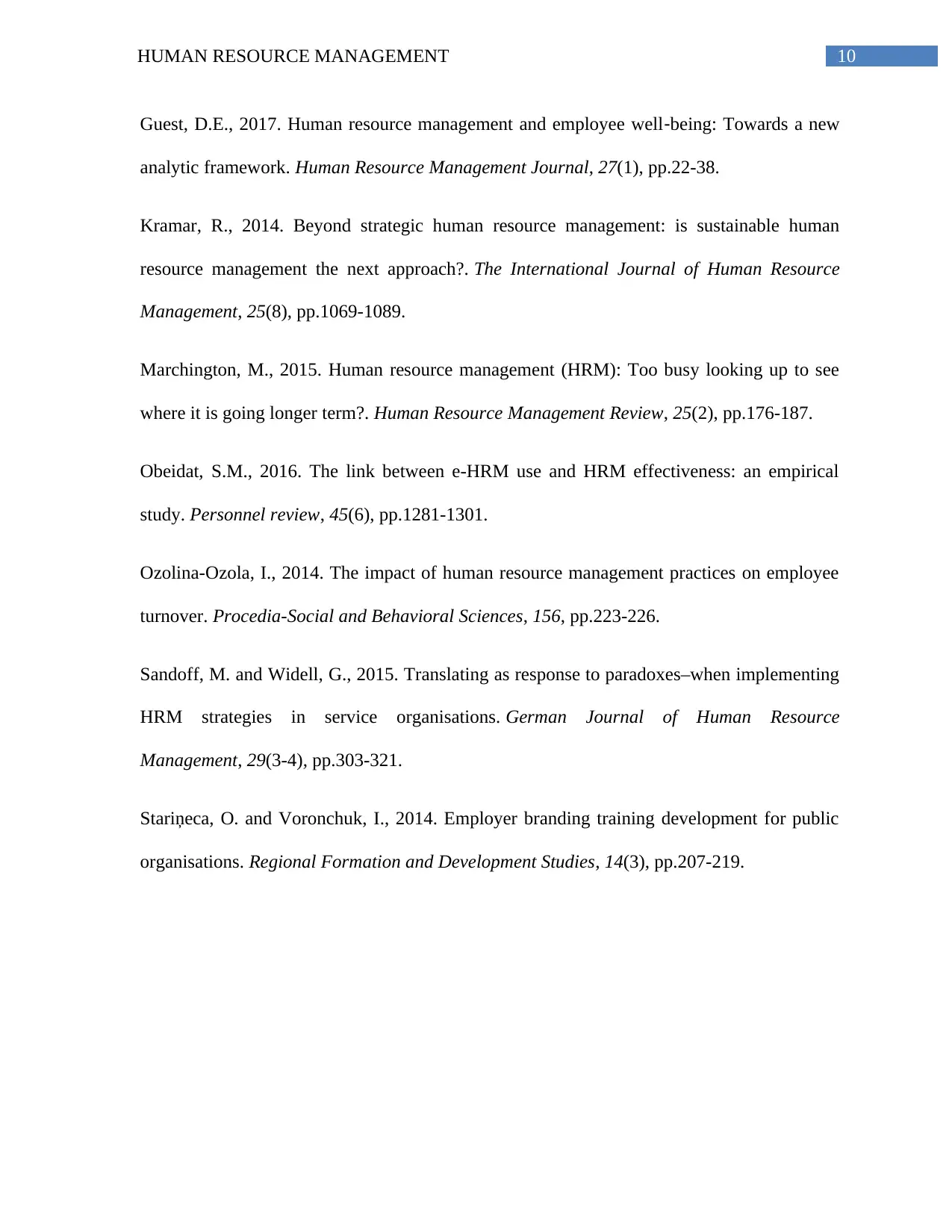
10HUMAN RESOURCE MANAGEMENT
Guest, D.E., 2017. Human resource management and employee well‐being: Towards a new
analytic framework. Human Resource Management Journal, 27(1), pp.22-38.
Kramar, R., 2014. Beyond strategic human resource management: is sustainable human
resource management the next approach?. The International Journal of Human Resource
Management, 25(8), pp.1069-1089.
Marchington, M., 2015. Human resource management (HRM): Too busy looking up to see
where it is going longer term?. Human Resource Management Review, 25(2), pp.176-187.
Obeidat, S.M., 2016. The link between e-HRM use and HRM effectiveness: an empirical
study. Personnel review, 45(6), pp.1281-1301.
Ozolina-Ozola, I., 2014. The impact of human resource management practices on employee
turnover. Procedia-Social and Behavioral Sciences, 156, pp.223-226.
Sandoff, M. and Widell, G., 2015. Translating as response to paradoxes–when implementing
HRM strategies in service organisations. German Journal of Human Resource
Management, 29(3-4), pp.303-321.
Stariņeca, O. and Voronchuk, I., 2014. Employer branding training development for public
organisations. Regional Formation and Development Studies, 14(3), pp.207-219.
Guest, D.E., 2017. Human resource management and employee well‐being: Towards a new
analytic framework. Human Resource Management Journal, 27(1), pp.22-38.
Kramar, R., 2014. Beyond strategic human resource management: is sustainable human
resource management the next approach?. The International Journal of Human Resource
Management, 25(8), pp.1069-1089.
Marchington, M., 2015. Human resource management (HRM): Too busy looking up to see
where it is going longer term?. Human Resource Management Review, 25(2), pp.176-187.
Obeidat, S.M., 2016. The link between e-HRM use and HRM effectiveness: an empirical
study. Personnel review, 45(6), pp.1281-1301.
Ozolina-Ozola, I., 2014. The impact of human resource management practices on employee
turnover. Procedia-Social and Behavioral Sciences, 156, pp.223-226.
Sandoff, M. and Widell, G., 2015. Translating as response to paradoxes–when implementing
HRM strategies in service organisations. German Journal of Human Resource
Management, 29(3-4), pp.303-321.
Stariņeca, O. and Voronchuk, I., 2014. Employer branding training development for public
organisations. Regional Formation and Development Studies, 14(3), pp.207-219.
1 out of 11
Related Documents
Your All-in-One AI-Powered Toolkit for Academic Success.
+13062052269
info@desklib.com
Available 24*7 on WhatsApp / Email
![[object Object]](/_next/static/media/star-bottom.7253800d.svg)
Unlock your academic potential
Copyright © 2020–2025 A2Z Services. All Rights Reserved. Developed and managed by ZUCOL.




